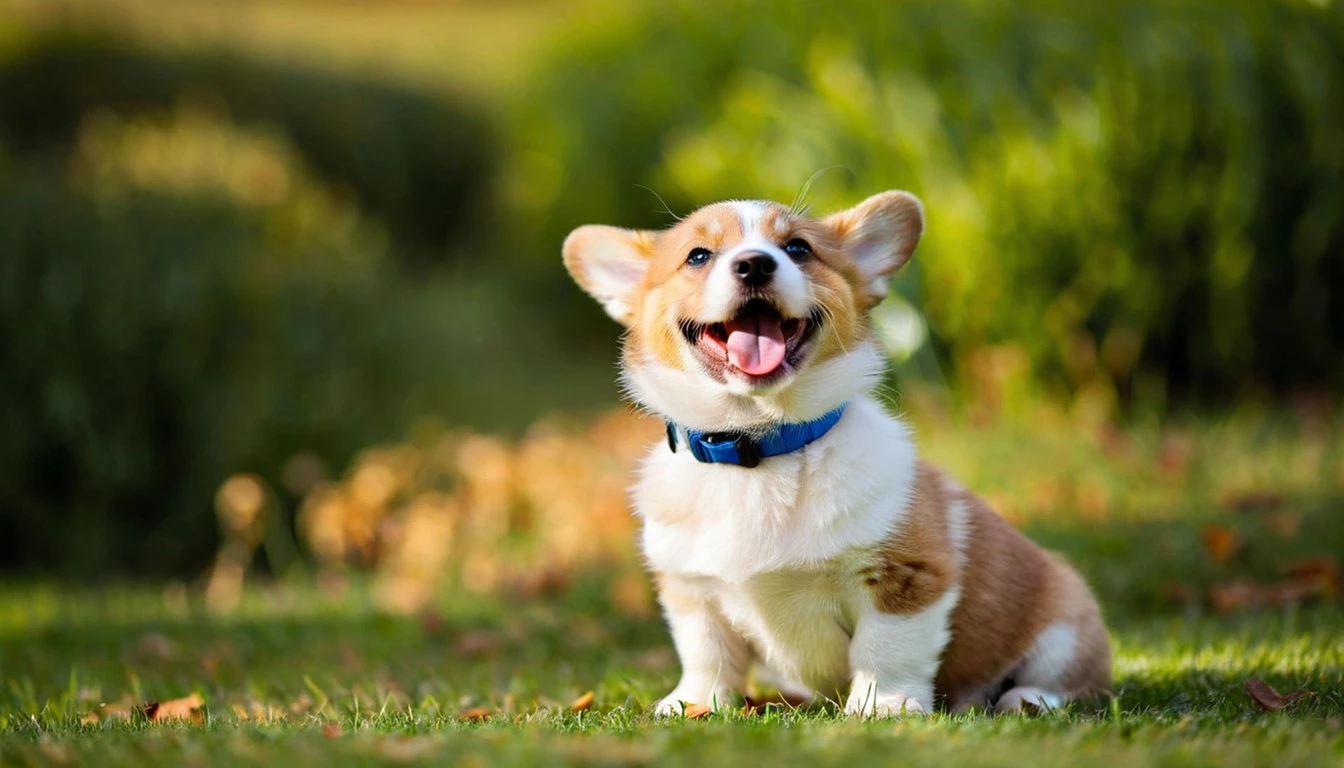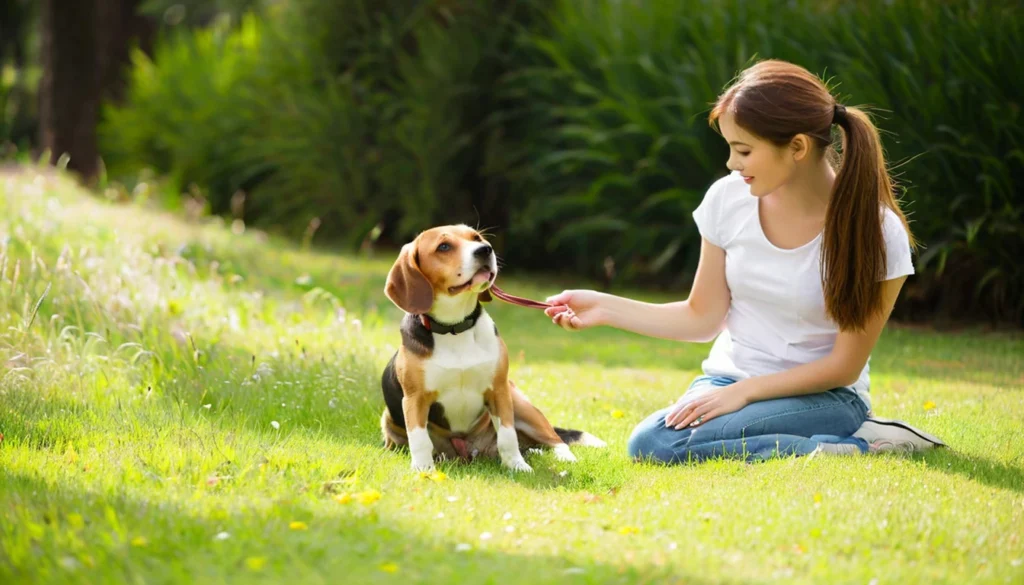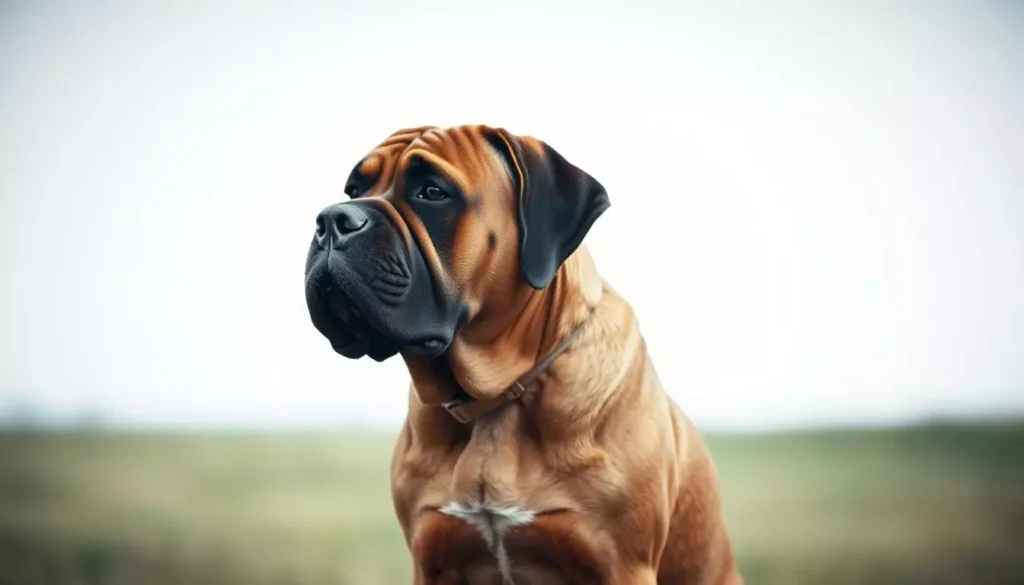As I watch my dog, I feel a strong bond with her unique traits. Her whiskers, long and proud, help her move through the world with ease. I often wonder, is it safe to trim her whiskers?
As a dog owner, I've thought a lot about this. It's a question many pet lovers have. Let's look into this together, thinking about our dogs' well-being. Is trimming whiskers okay, or could it harm them?
Key Takeaways
- Dog whiskers serve important sensory functions.
- Trimming whiskers can affect a dog's navigation abilities.
- Many dog owners question if it’s harmful to cut whiskers.
- Consulting a vet can provide tailored advice for your pet.
- Some breeds have varying grooming needs related to whiskers.
Understanding Dog Whiskers
Dog whiskers, or vibrissae, are fascinating features that play a big role in a dog's world. These special hair-like structures are not just for looks; they are vital as dog sensory organs. They are found on the upper lip, chin, and above the eyes. They are thicker and stiffer than regular fur, making them more sensitive to touch.
The role of dog whiskers is huge. They help dogs feel textures and move through tight spots. They are great at measuring distances, helping dogs know how much space is around them. Whiskers act like a radar system, giving dogs important info about objects nearby. This is key for their safety and awareness in different situations.
Learning about dog whiskers helps us understand their overall health. Watching my dog, it's clear these sensory organs greatly improve their life. They affect how they interact with their environment.
What Are Dog Whiskers?
The definition of dog whiskers refers to special hairs called vibrissae. They play key roles in canine dog anatomy. Unlike regular fur, whiskers are thicker and grow deeper in the skin. This gives dogs a better sense of touch.
These hairs can reach beyond the dog's face. They help dogs move around safely.
Each whisker comes from its own follicle. This makes them vital for feeling things. When a dog gets close to something, the whiskers pick up on air changes.
This skill lets dogs know about objects, measure spaces, and check if they can squeeze through tight spots.
Dog whiskers are a big part of how dogs understand their world. They help dogs move and interact better every day. Knowing about these special hairs makes us appreciate our pets more.
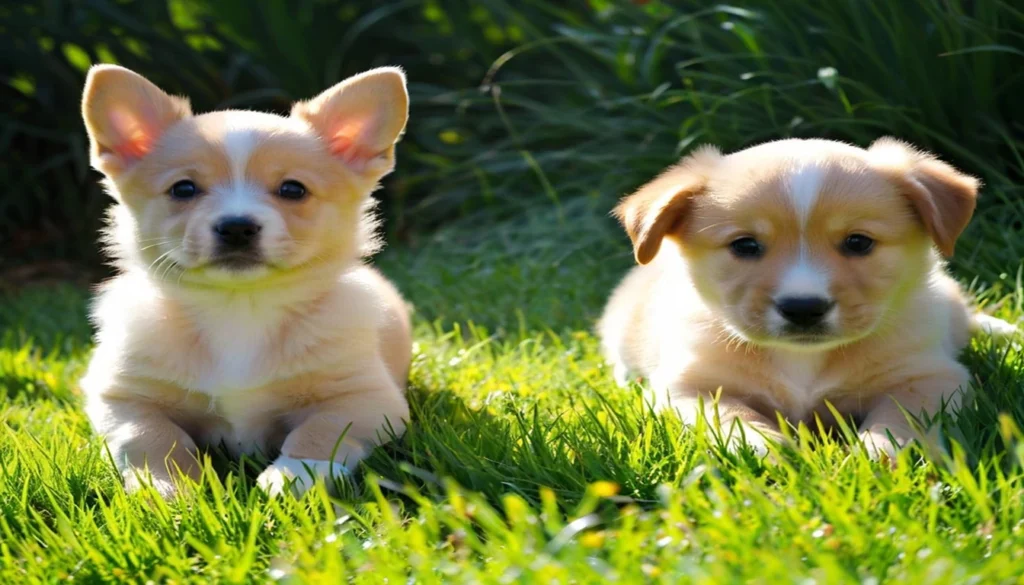
Why Do Dogs Have Whiskers?
Dog whiskers are more than just a fashion statement. They are vital for dogs to sense their surroundings. These special hairs are filled with nerve endings that help dogs feel objects nearby. This helps them move through tight spots and avoid hitting things.
Whiskers also help dogs figure out how big and fast things are coming towards them. This is super useful when it's dark and they can't see well. Knowing why dogs have whiskers helps us understand their behavior and instincts. It shows how important whiskers are for their survival and comfort.
Is It Okay to Cut Dog Whiskers?
Many dog owners wonder if it's okay to trim their dog's whiskers. Some groom their dogs, including trimming whiskers, especially if the fur is long. They do this to keep their dog clean, as food can get stuck in long whiskers. Knowing why owners trim whiskers can help understand the situation better.
Potential Reasons for Cutting Whiskers
There are a few reasons why dog owners might trim their dog's whiskers. Some include:
- Hygiene: Long whiskers can trap food and dirt.
- Aesthetics: Owners might want their dog to look a certain way.
- Ease of Maintenance: Shorter whiskers are easier to clean in some breeds.
Effects of Cutting Whiskers
Trimming whiskers can affect a dog's sense of touch. Whiskers help dogs feel their way around. Some owners have noticed changes in their dog's behavior after trimming whiskers, such as:
- Increased Caution: Dogs might be more careful in new places.
- Altered Navigation: They might change how they explore.
- Changes in Behavior: They might interact more or less with their owners or other pets.
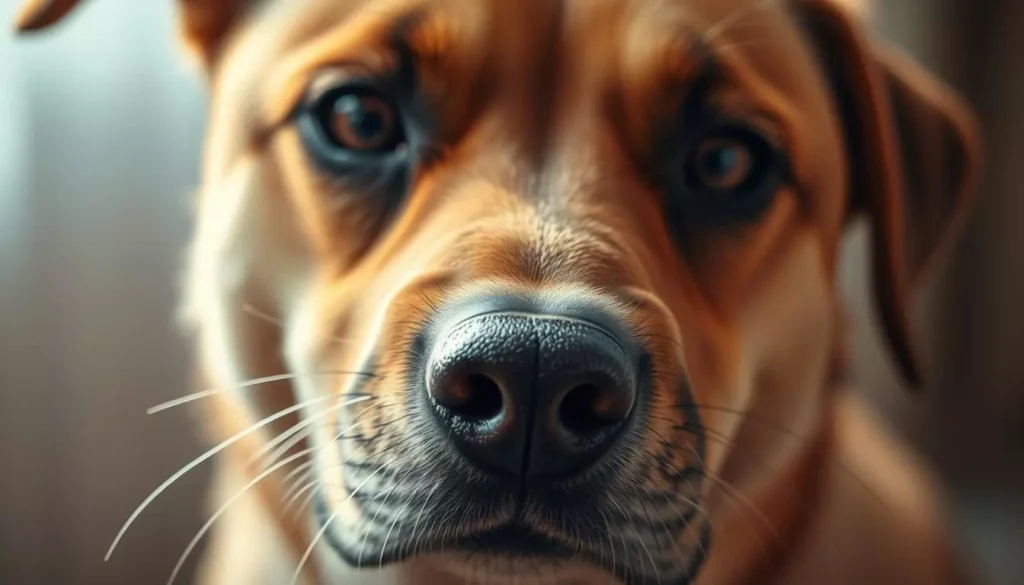
Do Dog Whiskers Affect Sensory Perception?
Understanding dog whiskers is key to knowing their senses. Whiskers, or vibrissae, are vital for dogs. They help dogs feel their surroundings better.
These sensitive hairs are crucial for dogs with poor vision. They help dogs know the size of spaces and find objects nearby. This makes them more aware of their space.
Whiskers and Navigation
Whiskers are essential for dogs to move around. They pick up on touch signals, helping dogs avoid things. This is very important for dogs that can't see well.
These hairs make dogs' senses better. They help dogs react fast to changes around them.
How Whiskers Help Dogs in Different Environments
Whiskers help dogs in many places. In dark or tight spots, they act like a radar. Dogs can feel walls, furniture, or other things with their whiskers.
This touch feedback is key. It lets dogs stay comfortable and confident in different places. Whiskers and senses are closely linked, showing how important they are for dogs.
Typical Practices Among Dog Groomers
Dog grooming practices vary a lot, depending on the dog's breed and needs. As a dog owner, knowing what groomers do is key to your pet's health. Groomers aim to keep dogs clean and looking good, making sure their coats are neat and shiny.
Grooming Techniques for Different Breeds
Every dog needs its own grooming style. For long-haired dogs like Afghan Hounds, groomers use special brushes to avoid tangles. Poodles need regular haircuts to keep their fur curly, while Beagles get brushed to remove loose hair.
These grooming methods show how important it is to know what your dog needs.
When and Why Groomers Trim Whiskers
Groomers trim whiskers for looks and cleanliness. Whiskers can get dirty and look messy. Some breeds have long whiskers that might get in the way or distract them.
Trimming whiskers helps improve a dog's look and keeps them comfortable. Knowing about these grooming choices helps dog owners make better decisions for their pets.
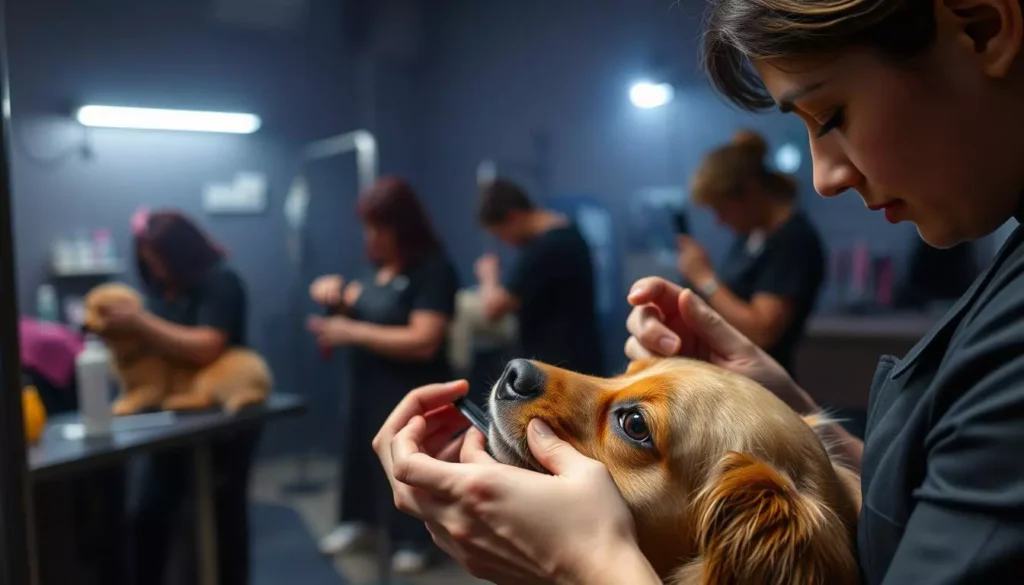
Does It Hurt a Dog to Cut Their Whiskers?
Many pet owners wonder about trimming their dog's whiskers. They often ask, does it hurt a dog to cut their whiskers? It's important to understand how dogs might react to this.
Cutting whiskers can be a sensitive topic. Whiskers are deeply rooted in the skin and have nerve endings. But, they are not as sensitive as cutting nails or fur. If done carefully with the right tools, it shouldn't hurt. It's key to make the process as comfortable as possible for the dog.
Understanding Whisker Pain Response
Dogs have a pain response similar to humans. They might react if they feel discomfort. When thinking about cutting whiskers, it's helpful to think about how to minimize negative reactions.
Ensuring a calm environment and using sharp, well-maintained scissors are important. Knowing how to properly hold and handle the dog during this process can make a big difference. It can significantly affect their overall experience.
Behavioral Changes After Cutting Whiskers
Many pet owners see changes in their dogs after trimming their whiskers. This shows how a dog's personality can change after grooming. Knowing these changes helps owners understand how whisker trimming affects their pets.
Common Observations from Pet Owners
People notice different things in their dogs after trimming. Some see changes, while others don't notice anything. Here are some common things pet owners see:
- Altered communication: Dogs use their whiskers to talk to each other. Some owners say their pets seem less expressive or have different body language.
- Increased caution: Some dogs are more careful in new places. This might be because they miss the sensory help their whiskers gave.
- Heightened curiosity: Others say their dogs are more curious and want to explore. This could be because they're trying to make up for missing sensory input.
- Indifference: But not all dogs change; some owners say their pets act the same as always.
| Behavioral Changes | Owner Observations |
|---|---|
| Altered communication | Less expressive body language |
| Increased caution | Wariness in new spaces |
| Heightened curiosity | More exploratory behavior |
| Indifference | No noticeable change |
Understanding how dogs act after whisker trimming is important. Seeing how your dog reacts can help you make better grooming choices. It's all about taking care of them in the best way possible.
Importance of Speaking with Your Veterinarian
It's crucial to consult a veterinarian about dog whiskers before trimming them. Each dog is different, and what works for one might not work for another. A vet can give advice on if trimming is right and safe for your dog.
Getting veterinary advice for dog grooming helps me know the best grooming for my dog. A vet's advice can help me understand the effects of trimming whiskers. They can also teach me how to groom my dog properly.
A vet can also look at any health issues that might affect grooming. Working with a vet ensures my dog gets the best care. It also makes sure they are comfortable and safe during grooming.
Can Whiskers Grow Back After Trimming?
Many dog owners wonder if dog whiskers grow back after trimming. The good news is, yes, they do. Whiskers, like other hair, have a growth cycle. After trimming, it takes time for them to grow back, depending on the dog's age, health, and breed.
How fast whiskers grow back varies. Younger and healthier dogs grow them faster. Older dogs might take longer. Keeping your dog well-nourished and healthy helps them grow whiskers faster.
When whiskers are growing back, they might look uneven or sparse. This is normal. Owners should give them time to get back to their full length and thickness. A good grooming routine helps keep the coat healthy, speeding up whisker recovery.
Are There Specific Breeds That Require Whisker Trimming?
Some dog breeds need their whiskers trimmed more than others. Poodles, for example, have long, fancy coats that include their whiskers. Trimming keeps them looking neat and clean around their mouth.
Schnauzers also need their whiskers trimmed. Their facial hair is part of their charm, but it can get messy. Trimming keeps them looking good and prevents food from getting stuck.
For these breeds, grooming is more than just looks. It keeps them comfortable and clean. It's also a special time to bond with your dog.
| Dog Breed | Description | Whisker Trimming Frequency |
|---|---|---|
| Poodle | Known for their curly coat and refined elegance. | Every 4-6 weeks |
| Schnauzer | Features a distinctive beard and eyebrows, requiring consistent grooming. | Every 4-8 weeks |
| Yorkshire Terrier | Has a long, flowing coat that may require whisker management. | Every 3-4 weeks |
Knowing what grooming your dog needs is key to their happiness. Regular whisker trimming makes them look and feel their best.
Whisker Care and Maintenance
Caring for dog whiskers is key to their health. Just like we groom our pets, whisker hygiene is important. Regular checks and cleanings keep them in top shape.
Adding whisker hygiene to grooming routines makes a big difference. A soft, damp cloth can clean food and dirt from whiskers. This keeps them looking good and feeling comfortable.
Diet is also vital for whisker health. I make sure my dog eats well, with lots of nutrients. Foods rich in vitamins and plenty of water help keep them strong.
I watch for any signs of whisker problems. Changes in length, color, or texture mean something's wrong. Regular checks help catch these issues early.
How to Properly Trim Dog Whiskers
Trimming dog whiskers is a delicate task. I want to share tips and safe techniques to help you. Choosing the right tools is key to a smooth experience for your dog.
Tools and Techniques for Safe Trimming
Using the right tools is crucial for safe and precise trimming. Here are some tools and techniques to consider:
- Scissors: Choose rounded-tip scissors made for pet grooming. They are safer and reduce the risk of nicks.
- Clippers: A small pet clipper is good for thick whiskers. Make sure it's quiet to avoid scaring your dog.
- Comb: Use a comb to separate whiskers before trimming. It helps for an even cut and prevents cutting too much.
- Grooming Table: A stable surface keeps your dog secure. A groomer’s table can make the process easier for both of you.
Safe trimming techniques are just as important as the right tools. Follow these steps:
- Make sure your dog is calm. Use treats or their favorite toy to keep them relaxed.
- Start with a light combing of the whiskers to detangle any knots.
- Trim gently, cutting only a small length at a time. Avoid cutting to the skin to prevent injury.
- Regularly check your progress to ensure you are achieving an even trim.
- Praise your pet throughout the process to create a positive experience.
Conclusion
Dog whiskers are key to their sense of touch and happiness. While it's okay to trim them, we must think about the dog's breed and needs. Every dog is different, and their feelings should guide us when deciding about their whiskers.
Looking back, we see how vital whiskers are for dogs. They help dogs move around and interact with their world. So, trimming whiskers should be done carefully and with knowledge. Talking to a vet can help us make the right choice for our dogs.
Understanding dog whisker care shows us how important they are. Whether we choose to trim or not, making smart choices improves our dogs' lives. It also makes our bond with them stronger.

